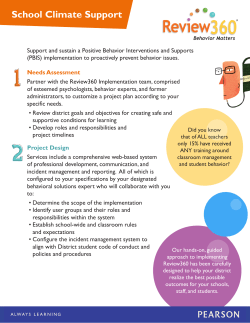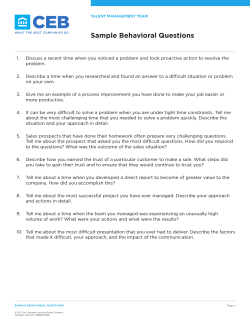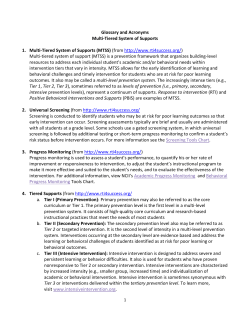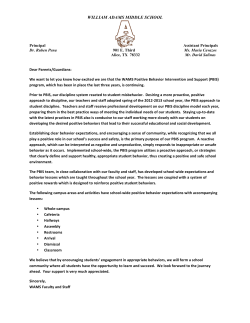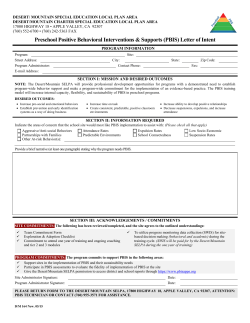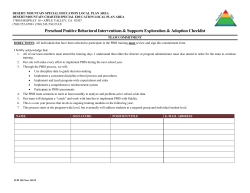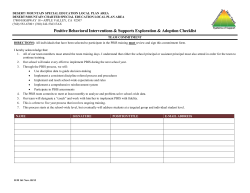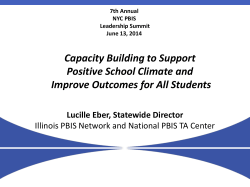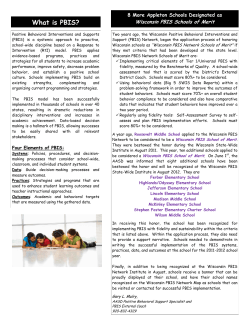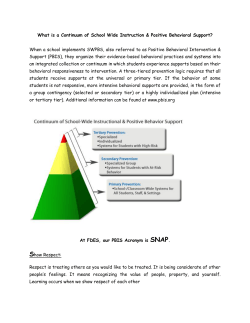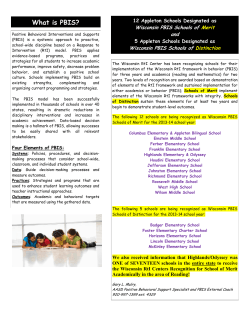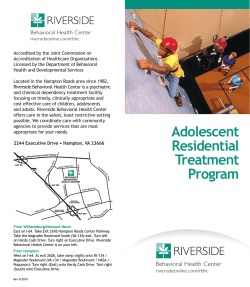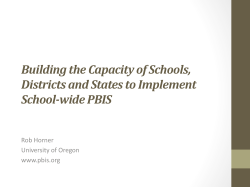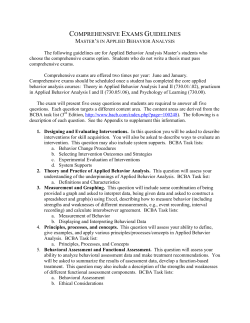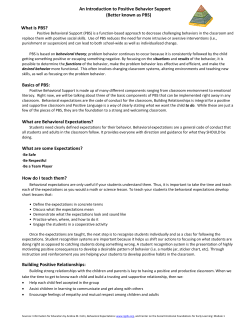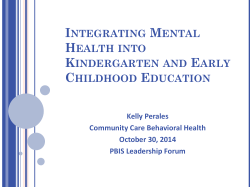
3/21/2014 Inclusion Activity: Sentence Frames
3/21/2014 Taking a Look at PBIS Positive Behavioral Interventions & Supports Inclusion Activity: Sentence Frames • Managing behavior at our school is like _________________ , • Because __________________________________. WHAT IS SW-PBIS? • What is it? • Logic • 8 Steps of Implementation 1 3/21/2014 What is School-Wide PBIS? • Improving student academic and behavior outcomes is about ensuring all students have access to the most effective and accurately implemented instructional and behavioral practices and interventions possible. • School‐wide Positive Behavioral Interventions and Supports provides an operational framework for achieving these outcomes. What is School-Wide PBIS? • More importantly, PBIS is: – NOT a curriculum, intervention or practice but – IS a decision‐making framework that guides selection, integration and implementation of the best evidence‐based academic and behavioral practices for improving important academic and behavior outcomes for all students. The “Logic” of PBIS 2 3/21/2014 Continuum of Interventions Tier One Tier Two • School‐wide expectations • Bully Prevention • Character Education Tier Three • CICO • Social Skills Group • Anger Management • Mentoring • FBA • BSP • Wraparound • Person Centered Planning Establishing a Positive Social Culture Common Language MEMBERSHIP Common Experience Common Vision/Values What does School-Wide PBIS look like? • >80% of students can tell you what is expected of them & give behavioral examples because they have been taught, actively supervised, practiced, & acknowledged. • Positive adult‐to‐student interactions exceed negative. • Function based behavior support is the foundation for addressing problem behavior. • Data‐ & team‐based action planning & implementation are operating. • Administrators are active participants. • A full continuum of behavior support is available to all students. 3 3/21/2014 So, what does this look like? • Step One: Establish Team Membership – Demographically representative of school and community – Represents grade levels – Includes a member with behavioral/classroom management expertise – Administrator is an active member So, what does this look like? • Step Two: Develop a Brief Statement of Behavioral Purpose – Positively stated – Limit of 2‐3 sentences – Supportive of academic achievement – Comprehensive in scope—ALL students, staff and settings 4 3/21/2014 Behavioral Statement of Purpose Example “Abraham Lincoln School is a community of learners. We are here to learn, grow, and become good citizens.” Non‐example “We, at Old School Elementary, believe that fear instilled in young children and corporal punishment still work.” So, what does this look like? • Step Three: Identify Positive School‐ wide Behavioral Expectations – 3‐5 expectations – 1‐3 words to describe each expectation – Positively stated 5 3/21/2014 So, what does this look like? • Step Four: Develop Procedures for Teaching School‐wide Behavioral Expectations – Teach behavioral expectations just like academics – Create a school‐wide teaching matrix for all settings in the school – Positively define what each expectations “looks like” in each setting Curriculum Matrix Location 1 Location 2 Location 3 Location 4 Location 5 Location 6 Expectation 1 Expectation 2 Expectation 3 Expectation 4 Expectation 5 SETTING Expectations Teaching Matrix All Settings Hallways Playground s Cafeteria Library/ Comput er Lab Assembly Bus Respect Ourselves Be on task. Give your best effort. Be prepared. Walk. Have a plan. Eat all your food. Select healthy foods. Study, read, compute. Sit in one spot. Watch for your stop. Respect Others Be kind. Hands/fee t to self. Help/shar e with others. Use normal voice volume. Walk to right. Play safe. Include others. Share equipment. Practice good table manners Whisper. Return books. Listen/watch . Use appropriate applause. Use a quiet voice. Stay in your seat. Respect Property Recycle. Clean up after self. Pick up litter. Maintain physical space. Use equipment properly. Put litter in garbage can. Replace trays & utensils. Clean up eating area. Push in chairs. Treat books carefully. Pick up. Treat chairs appropriately . Wipe your feet. Sit appropriately . 6 3/21/2014 So, what does this look like? • Step Five: Develop Procedures for Teaching Classroom‐wide Behavioral Expectations – Teach behavioral expectations just like academics – Create a classroom teaching matrix for all routines that occur during your instructional day – Positively define what each expectation “looks like” for each routine So, what does this look like? • Step Six: Develop Continuum of Procedures for Encouraging and Strengthening Student Use of School‐wide Behavioral Expectations – Create quick and easy ways to reinforce and acknowledge school‐wide expected behaviors – Develop a system to integrate the reinforcers into a meaningful continuum that creates value for students – Used by all staff in all settings – Keep track of number of acknowledgements versus the number of disciplinary actions 7 3/21/2014 Acknowledge & Recognize So, what does this look like? • Step Seven: Develop Continuum of Procedures for Discouraging Student Behavioral Violations of School‐wide Behavioral Expectations – Create an Active Discipline Flowchart that identifies steps to take when students do not meet the desired behavioral expectations – Define the difference between major (office managed) and minor (classroom managed) problem behavior – Create an office discipline referral (ODR) form for tracking discipline events Active Flow Chart 8 3/21/2014 So, what does this look like? • Step Eight: Develop Data‐based Procedures for Monitoring Implementation of School‐wide PBIS (SWPBIS) (Primary or Universal Tier) – Establish a structure and routine for data collection – Use SWIS (School‐wide Information System) or a comparable data collection system when creating routines and procedures for review and analysis of data – Systems must be effective, efficient and relevant (pbssurveys.org) The SWIS “Suite” School-wide Information Systems SWIS o School‐wide Information System CICO o Check‐in/Check‐Out ISIS o Individual Student Information System PBIS Assessments by Tier • PBIS Assessments (surveys) are implemented at each tier to assist teams to monitor their progress and fidelity of interventions Research Tool Annual Assessment Tool Progress Monitoring Tool Universal Intervention (Tier I) SET BoQ SAS ECBoQ TIC Targeted & Intensive Intervention s (Tiers II & III) ISSET coming soon SAS BAT MATT From PBISApps.org. 9 3/21/2014 Summary • School‐wide PBIS is an approach for investing in making the school a more effective social and educational setting for ALL students. • PBIS is based provides an effective framework for improving Behavior and Academic Support. Checking for Understanding "Tweet" • With an elbow partner, write a Tweet that explains PBIS in … characters or less. • Share your Tweet with your table group. • Pick one Tweet to share with the whole group. "You can't live a perfect day without doing something for someone who will never be able to repay you." — John Wooden 10
© Copyright 2025
